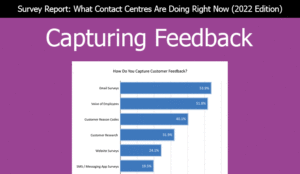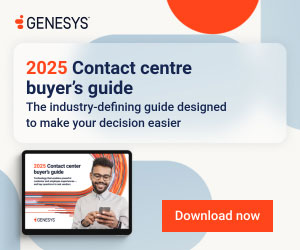We asked our panel of experts for their advice on how often companies should seek customer feedback, and how they can determine what frequency works for them.
When looking to collect customer feedback you first need to:
Determine Why You Are Collecting Customer Feedback
Brands have more ways to ask for customer feedback than ever, from email surveys about products and service experiences, to chat follow-up that rates contact centre agent performance, to text, in-app, in-product, and website ratings, and social media reviews. However, ease of access can easily translate to pestering customers.
Before determining when to seek input, companies should answer the why, how, and how much of these efforts and communicate these factors clearly.
For example, the amount of time prospects and customers spend answering questions drops precipitously across longer surveys.
They’re willing to spend 75 seconds on a one-question survey, but only 19 seconds per question on a 26- to 30-question survey. As a result, feedback quality suffers.
It’s equally important that companies share how they will use input to make customer experiences better, providing customers with a rationale for investing their time.
Contributed by: Holly Larson at Cyara
Five Tips to Identify How Often You Should Seek Customer Feedback
There are a number of factors that influence how often customer feedback should be collected and our experts have outlined some of the basics to help you find what works best for your company:
1. Identify What Type of Customer You have

Identifying the different types of customer interactions can help determine how often you should be seeking customer feedback.
Transactional customers are driven by quick, easy, and cost-effective purchases. A well-monitored and immediate customer feedback survey sent to transactional customers as soon as they interact with the brand can help facilitate responses.
Relational customers are driven by brand trust, expertise, and loyalty. Tracking customer feedback for relational customers over 30-, 60- or 90-day intervals can help drive accurate and timely responses.
Extracting those ‘moments of truth’ when capturing customer feedback can also help facilitate a successful voice of the customer programme. Consider setting up a pilot customer feedback survey as a proof of concept to help drive this.
Testing target audiences, channel types and customer contact frequency within this pilot programme can help enable a successful customer feedback strategy.
Contributed by: Mo Hassan at Business Systems
2. Identify How Often You Have Regular Contact With Your Customers

The frequency and types of questions will impact feedback results.
If you have regular contact with your customer base, seeking feedback once every six months is the ideal time period.
If contact is made on an ad hoc basis, it’s better to ask for feedback after each interaction, as you don’t know when your next opportunity will be.
Try and keep the number of questions to a minimum, while still ensuring they have a key purpose, so answers will help you improve service or identify areas your business is doing well in.
Contributed by: Drew Naylor at MaxContact
3. Review Channel Use
Despite the proliferation of digital channels, most customers still use just a few ways to interact with contact centres.
In 2021, 62.2 percent of UK consumers seeking support called contact centres, 19.3 percent turned to email, 6.5 percent used webchat, and 5.1 percent turned to self-service tools such as knowledge bases and chatbots. All other channels, such as social media, letters, faxes, and SMS had a much lower response.
Customer experience teams need to consider these proportions in soliciting and evaluating feedback.
That may mean weighing phone input more than webchat, for instance. Brands can use automated testing to ensure top-performing channels function as expected and optimize the omnichannel experience for customers.
Direct digital channels should be leveraged more frequently to gain immediate customer feedback. Customers are usually ready to give feedback on service interactions, provided surveys are short, focused, and share why data is needed.
Contributed by: Holly Larson at Cyara
4. Consider if You Are Collecting Passive or Active Feedback
To avoid bombarding your customers with surveys, you must ensure that you gather both the passive and active feedback that they provide.
Passive Feedback
Passive feedback uses ‘always-on’ methodologies to harvest data from multiple digital sources. Social media provides excellent insight, especially because conversations can generate feedback from multiple users.
Review sites such as Trustpilot and Google Reviews are also rich sources of data, where customers tend to be especially truthful with the aim of providing useful information for future users of a product or service.
Pretty much any online space where customers talk about your brand can be mined to create a powerful and detailed view of their needs, wants and aspirations.
There are, however, two key requirements to unlocking the passive feedback goldmine: firstly, you need to be able to house all the data in one place, and secondly, you need technology to automate the analysis of so much unstructured data.
At Sabio, we favour the use of natural language processing (NLP) combined with sentiment analysis. This pairing not only tells you what your customers are saying, but crucially, how they feel about it, giving you the information you need to make the case for change.
Active Feedback

Active feedback relies on the traditional method of surveying your customers at different points in the customer journey – but choosing when to survey (and when not to!) is all-important.
We recommend using survey fatigue prevention measures to ensure that customers receive a survey no more than once within a 30-day period. This will free you up to design a robust and reliable voice-of-the-customer programme using both transactional and relationship surveys.
Transactional surveys measure customer loyalty and experience after a specific interaction or transaction. Organizations need to identify the critical touchpoints in their customer journey which, depending on your sector, could be anything from onboarding to post-contact or from repair to renewal.
Once identified, the next step is designing a survey that helps you measure your strategic customer outcomes at each touchpoint and identifying the most appropriate channel on which to send the surveys.
Once in place, your suite of transactional surveys will provide your organization with rich insight on the pain points in your customer journey and how they impact loyalty, as well as the aptitude and attitude of your employees and how that impacts loyalty.
Relationship surveys measure customer loyalty to your organization or brand as a whole, irrespective of any recent interactions. We typically recommend sending a relationship survey to your whole customer base every six or twelve months.
They are far more in depth than transaction surveys and have the advantage of talking to the ‘silent majority’ – those customers who you haven’t spoken to recently and therefore have no indication as to their loyalty or churn risk.
Contributed by: Francis Beard at Sabio
5. Determine How You Will Communicate Feedback Results

While our feedback goals typically include an array of metrics, communication of the results of the feedback is vital.
Your customers will look much more favourably on a business that can take their comments, concerns and questions and make changes, enhancements or simply keep doing what they like, rather than simply providing feedback into the ether. Ultimately, customer satisfaction is predicated on results.
Feedback goals should reach for the stars but remain grounded in the reality that customer experience, customer service and issue resolution are all subject to points of failure. Frequency of feedback is relative, but it should coincide with releases, rollouts, and your marketing roadmap.
General feedback is great, but it provides little insight if your organization simply wants to gauge general feeling. Connecting feedback to your business plan will allow you to understand and customize future campaigns based on the success and opportunities of past endeavours.
Contributed by: Julian Evans at Alvaria
So the question remains, how often should you seek customer feedback?
Our experts have provided a number of theories to help you decide:
Continually

The only point in gathering feedback is to inform strategy, so data must be current, comparable and complete. Using last year’s data collected from an unrepresentative demographic could be worse than a theoretical or subjectively informed strategy.
Well-planned continuous feedback can help even out bias in the sample and create data which can be cut and sliced to drill down for specific comparisons.
Financial or technological constraints also mean that setting up a simple self-perpetuating feedback system that just requires data interpretation can be more accessible to some organizations.
Of course, there are limitations and flaws to any feedback survey, but simplicity makes participation more likely and therefore more representative.
Remember that a lot of data is available from contact centre solutions so continuous feedback should focus on the questions and topics that will always matter to customers, such as:
- “Was the agent / service helpful?”
- “Would you use this service again?”
Contributed by: Richard Gregory at Odigo
Round the Clock

Customers should always have the opportunity to share feedback. Of course, this does not mean spamming them with surveys and becoming notorious for junk mail. However, appearing receptive to feedback strengthens the brand image and gathers more insight.
As such, contact centres should consider non-invasive methods to gather feedback. For example, including a comment mechanism in email signatures, scouring third-party review sites, and providing online voice of the customer (VoC) portals all enable operations to create a continuous stream of customer insights.
CX analytics is another potential solution. It distils complex omnichannel interactions, revealing trends, spotting pain points and predicting customer needs. It also helps visualize the results by providing graphs and diagrams.
Finally, little and often pop-ups may gain results, but all this must be part of a broader VoC programme. After all, survey tools are not the only method for gathering and analysing customer feedback. Those that think otherwise risk survey fatigue.
Contributed by: Jade Turley at Calabrio
Real-Time and Post-Interaction

The short answer is not often but continuously – made possible by artificial intelligence. You can get smarter with every customer interaction automatically. AI sentiment analysis is an effective tool to enable companies to get accurate customer feedback in real time across all interactions
Although post-interaction customer feedback can be helpful, such data is diagnostic and therefore anchored in the past.
Despite action being taken to improve future outcomes, there is little that an agent can do to change the bad experience that a customer has or is currently experiencing. Customer feedback needs to be real time and post-interaction.
AI also improves over time, adapting to changing requirements constantly to mitigate risks and possible complaints.
It streamlines complaint management programmes and helps organizations to prevent future complaints, by giving managers the insights to strengthen the customer experience. Furthermore, it focuses on skills such as empathy and offers feedback on how to best communicate with each individual customer.
Contributed by: Lauren Maschio at NICE
At the End of the Call
Customer feedback is critical to any business and is the ultimate tool for insight into your customer base.
Customer feedback should focus on how to obtain authentic, informative feedback (as opposed to how often).
One of the most valuable times to collect input is at the end of the call. At this moment, the conversation is fresh in your customer’s mind. Since they are already interacting with your business, you’re more likely to get a response.
Make “how did we do today?” your last interaction with each customer. You can also choose to add feedback as part of a follow-up conversation.
Send a text, an email, or a message on your customer’s go-to communication channel. Consider the customer journey and determine the best way to incorporate your method of feedback. But don’t overwhelm them with too many requests; keep it condensed and straightforward!
Contributed by: Geomant
When the Interaction Is Customer-Initiated
It would be great to ask for feedback after every touchpoint. With the numerous data points available, we can easily determine what customers have opened, clicked, seen or how they have interacted with an email, push notification, or cold call in an instant.
But feedback is rendered useless if it’s over-utilized or, worse yet, ignored.
A good rule of feedback is: if the interaction is customer-initiated (C2B), it’s more likely to be relevant and valuable to both parties. This includes both positive and negative touchpoints and provides a tremendous opportunity for improvement and insight in each scenario.
Contributed by: Julian Evans at Alvaria
Daily or Weekly Basis

Every day an unhappy customer can cost your business a lot of money. Therefore, it is important to evaluate your customer feedback on a regular basis so that you can prioritize and expedite frustrated customers interactions and ensure they walk away as happy customers.
How often you check your customer feedback depends on your business’s seasonality and industry. For example, if your business is in the hospitality industry, then customer satisfaction should be evaluated daily, especially during peak season.
One negative review online or experience can be detrimental for your business, especially when left ignored. Afterall, a bad customer service interaction is more likely to be shared than good experiences.
Contributed by: Sabine Winterkamp at Five9
Weekly (CSAT)

Listening to customers is essential to improve your organization’s customer experience, but endless requests for feedback can have the opposite effect. Understanding how often to collect feedback is just as important as knowing how to collect it.
Weekly CSAT surveys can generate effective feedback. It’s important to ensure you’re asking different customers every time, as this can lead to increased quit rates and lower quality of responses.
To survey proactively, organizations can reach out to customers 30 days after a purchase to ensure satisfaction or respond to complaints. Feedback can also be collected immediately after call centre interactions while experiences with your brand are fresh in customers’ minds.
With the right tools, it’s also possible to collect unsolicited feedback, which includes what customers are saying (and how) while an interaction is still going on without actively seeking it from the customer. Combining solicited and unsolicited feedback sources delivers a comprehensive view of CX and CSAT.
Contributed by: Frank Sherlock at CallMiner
Twice a Year Via Surveys

The traditional wisdom when gathering feedback via surveys is to ask customers twice a year at most. In doing so, companies avoid becoming associated with spamming – at least, that is the theory.
Many set this as a maximum threshold, meaning that not all customers receive as many as two surveys a year.
Instead, some will choose to send a survey to a particular segment first, track its progress, and estimate the percentage of customers that respond.
Using this calculation, companies can gauge how many customers need to receive the survey to achieve a reliable data set. Such a soft launch also allows operations to understand responses and abandon rates, enabling them to make changes and increase engagement.
Further tactics to increase survey engagement include shortening the question length, avoiding asking two things at once and taking the format for a test drive by asking agents whether they understand each question.
Contributed by: Jade Turley at Calabrio
Find a Sweet Spot
Is the problem that we ask for feedback too often, or that people have come to distrust the reason we’re asking for it in the first place?
Feedback should be a way for organizations to learn what customers are thinking so that they can make future improvements.
But in our recommendation-driven world, it’s now too commonly used as a marketing tool to say “our customers rate us a 5 out of 5”.
In fact, how many times have you been asked to submit feedback….. accompanied by the line ‘but please only do so if you give us a 5 because it would mean so much!’
It certainly leads me to look at the 1 out of 5 reviews as much as the 5 out of 5 reviews because the truth frequently lies somewhere in the middle.
The trick is to find a sweet spot. To gather enough feedback, by asking the right questions, at the right times (i.e. not for every single interaction), without overloading the customer.

And don’t just ask the same question all the time, such as “How likely are you to recommend us to your friends and family?” Look at the customer relationship, and the feedback you gather, from different angles.
Consider customer effort. Ask whether the issue has been resolved to the customer’s satisfaction (and not just first time). And use the information to identify the root cause of issues/problems so that they don’t happen again.
Above all, though, if the customer suggests an issue or an improvement, feedback to the customer on their feedback. That shows you are listening and that you care.
Contributed by: Michael Gray at Sensée
Let Customers Determine When, Where, Why, and How to Provide Feedback
The ability to interact on the communication channel of their choice is the most important facet of the feedback experience. This is a direct correlation with the ability of your business to provide an omnichannel customer experience.
A customer who can determine when, where, why, and how to provide feedback, and subsequently have the company respond accordingly won’t view these interactions as traditional customer service at all.
These self-directed interactions are more likely to generate positive, empowering experiences and set the stage for positive interactions when additional help is required.
Contributed by: Julian Evans at Alvaria
Every 6-12 Months

As a call centre the answer is always ‘with every interaction’.
For instance, if a business would like to know what the most used and unused features of a specific product are, your call centre agents could ask this of all customers who have the product when the customer calls in to the call centre.
This feedback can then help businesses structure survey questions and other data-gathering mechanisms. Customers who contact your call centre are more open to providing detailed feedback than if the business initiates contact requesting feedback. This is true even if they contacted you for a completely different reason.
All customer-initiated interactions, especially telephonic ones, are a valuable opportunity to gather information.
However, in relation to outbound surveys like customer feedback requests, how often would depend on the specific survey. Satrix Solutions suggests every 6-12 months for customer satisfaction surveys, I would say the same is true for any type of customer feedback request – not just satisfaction surveys.
Contributed by: Caroline Leonard at Spearline
For more great suggestions from our industry experts, read these articles next:
- The Best Metrics for Contact Centre Performance Tracking
- How to Improve Customer Satisfaction
- Top Tips to Monitor Customer Service
- Customer Experience Management – the Latest Thinking in Looking After Customers
Author: Robyn Coppell
Reviewed by: Rachael Trickey
Published On: 22nd Aug 2022 - Last modified: 1st Jul 2024
Read more about - Customer Service Strategy, Alvaria, Business Systems, Calabrio, CallMiner, Caroline Leonard, Customer Surveys, Cyara, Drew Naylor, Feedback, Five9, Frank Sherlock, Geomant, Lauren Maschio, MaxContact, NICE, Odigo, Sabio, Sensee, Spearline, Voice of the Customer






































